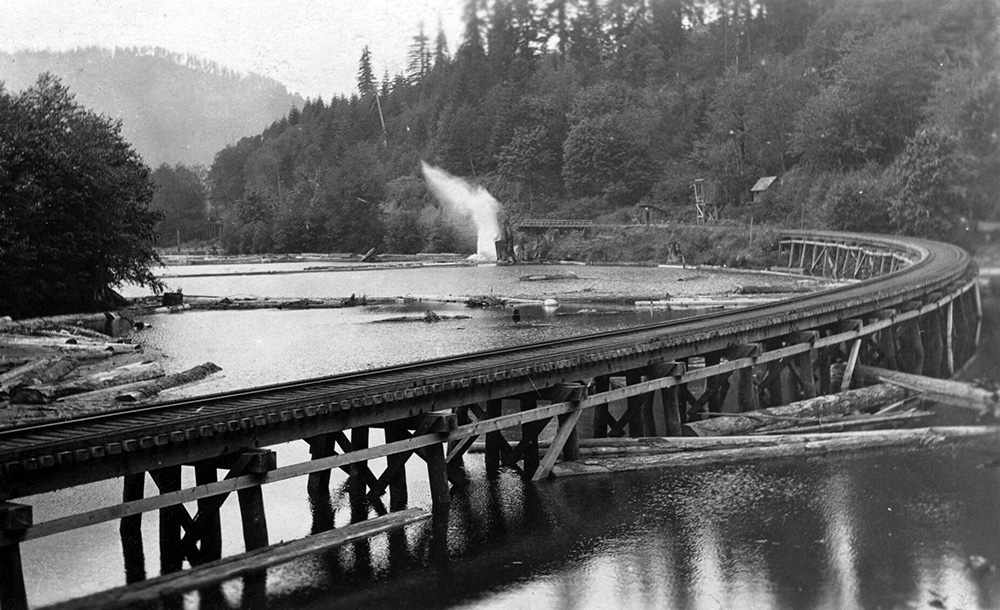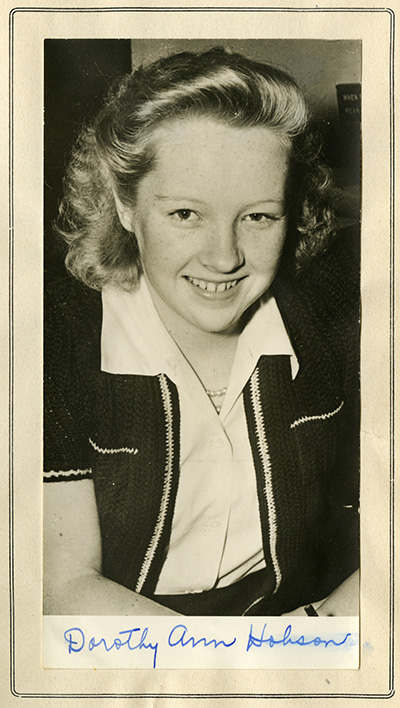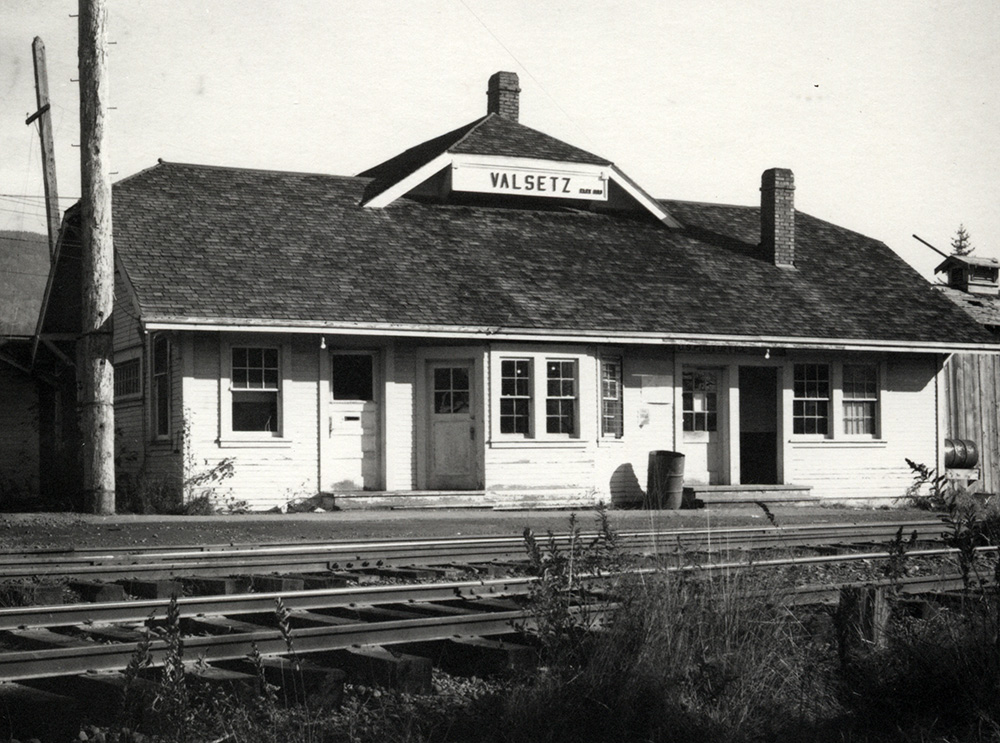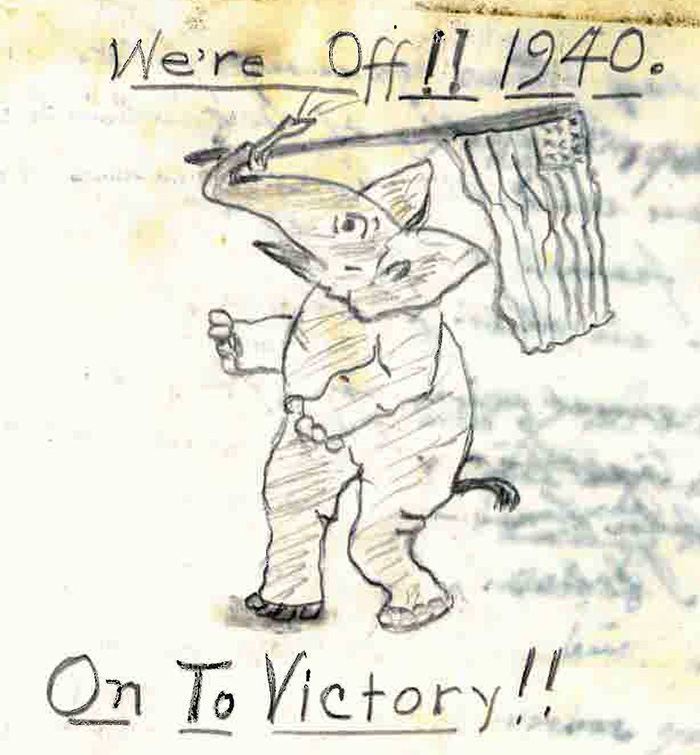

The Valley and Siletz Railroad followed the Luckiamute River to connect the city of Independence along the Willamette River to Valsetz. Enlarged image courtesy of Oregon State University, Special Collections and Archives, Gerald W. Williams Collection.
A 1910 forest fire in the Coast Range set the stage for the logging company town of Valsetz. Created in 1919 to harvest charred trees, early Valsetz was little more than a sawmill and company housing. It built a post office a year later and needed a name. The town was connected to the state by the Valley and Siletz Railroad, supposedly the inspiration for its unusual name.
Valsetz grew fast, and in a few years the town boasted not only dorms for single male loggers and mill workers, but also simple homes for families. Far from a ramshackle town, many buildings were crafted with skill and care. The company headquarters and company store were built in the Tudor Revival style popular at the time.
 Dorothy Anne Hobson, when she was the editor of The Valsetz Star, in the early 1940s. (Courtesy of Oregon State Library)
Dorothy Anne Hobson, when she was the editor of The Valsetz Star, in the early 1940s. (Courtesy of Oregon State Library)
Valsetz workers did not live on the jobsite like many others in squalid backwoods logging camps. Instead, company workers commuted into the forest on a narrow-gauge train that ran from the town into the woods.
Valsetz’s most famous resident was its preteen editor of
The Valsetz Star newspaper, a girl named Dorothy Anne Hobson. In 1937, nine-year-old Hobson determined she would create a newspaper for the people of Valsetz. She wrote the articles in pencil and handed off scripts to a family friend who then sent them to Portland for publishing. The papers were typed as received – misspellings and all – and printed on eight and a half by fourteen-inch mimeographed pages.
 The Valsetz Railroad Station in Valsetz in 1958. Enlarged image courtesy of Ben Maxwell Collection.
The Valsetz Railroad Station in Valsetz in 1958. Enlarged image courtesy of Ben Maxwell Collection.
According to Hobson in 1937, “We want to stand for something, so we had a meeting and we will stand for kindness. Also, we are a Republican paper, but we will not charge Democrats any more for a copy than a Republican…The Republicans are very sensible, but the Democrats are lots of fun.”
 A 1940 sketch by Dorothy Anne Hobson. (Courtesy of Oregon Historical Society)
Enlarge Image
A 1940 sketch by Dorothy Anne Hobson. (Courtesy of Oregon Historical Society)
Enlarge Image
Over a dozen major publications carried excerpts from
The Valsetz Star. Some were notable, including the Portland
Oregonian, Denver
Post,
Christian Science Monitor, New York
Herald-Tribune, and the Washington DC
Post. She received mail from celebrities and politicians like Shirley Temple and Herbert Hoover.
Hobson published
The Valsetz Star every month for four years – her final edition was in December of 1941. Afterward she moved with her family to Salem and attended Parrish junior high school. Hobson aimed to “improve her education, take music and vocal lessons, and have her teeth straightened, with no time left for anything except the Parrish Pep Club.”
In the 1950s the town had reached its zenith with 125 loggers, 260 mill employees, and a total population of over 1,000 people. The company town’s slow decline began in the next decade. By the 1970s, timber reserves were cut down and the railroads were abandoned. Officially closed in 1984, Valsetz’s many fine buildings were bulldozed and set ablaze. Decades of history and generations of memories burned along with them.